#hyperscale data center market
Explore tagged Tumblr posts
Text
Massive power consuming data centers won't save us.
Massive data centers consuming large amounts of energy have eyes on South Dakota By Joshua Haiar, South Dakota Searchlight Route Fifty December 9, 2024 ‘Utilities are getting calls every week,’ state regulator says. “We’re talking loads that eclipse some of the largest cities in South Dakota,” he said. A single data center campus can require anywhere from 300 to 500 megawatts of electricity to operate. One megawatt can power hundreds of homes. By one estimate, there are over 1,000 hyperscalers worldwide, with the U.S. hosting just over half of them. Ryan Long, president of Xcel Energy, headquartered in Minneapolis, illustrated the extreme nature of the demand. “We now have, I would say, north of seven gigawatts of requests across the Xcel Energy footprint for data centers to locate in one of our eight states,” he said. “And I’ll be very frank that there’s no way that we’re going to be able to serve all of that in a reasonable amount of time.” Protecting existing customers from potential costs or energy shortages is another shared concern. Utility representatives emphasized the need for coal and natural gas to maintain a reliable “base load” when renewable sources like wind and solar are unavailable.
Tech is not saving us.
#tech won't save us#power consumption#power plants#fossil fuel industry#electric grid#electric service#data centers#south dakota#regulators#government#state government#power shortages#tech giants#tech tycoons#tech hype#AI#data#megawatts#hyperscalers#hyperscale#public health#politics#hyperscale data center market#energy footprint#gigawatts#coal#natural gas#environment#climate change#climate catastrophe
0 notes
Text
The USA hyperscale data center market is expected to flourish until 2027 due to the increasing use of remote work and a rising need for cloud computing solutions.
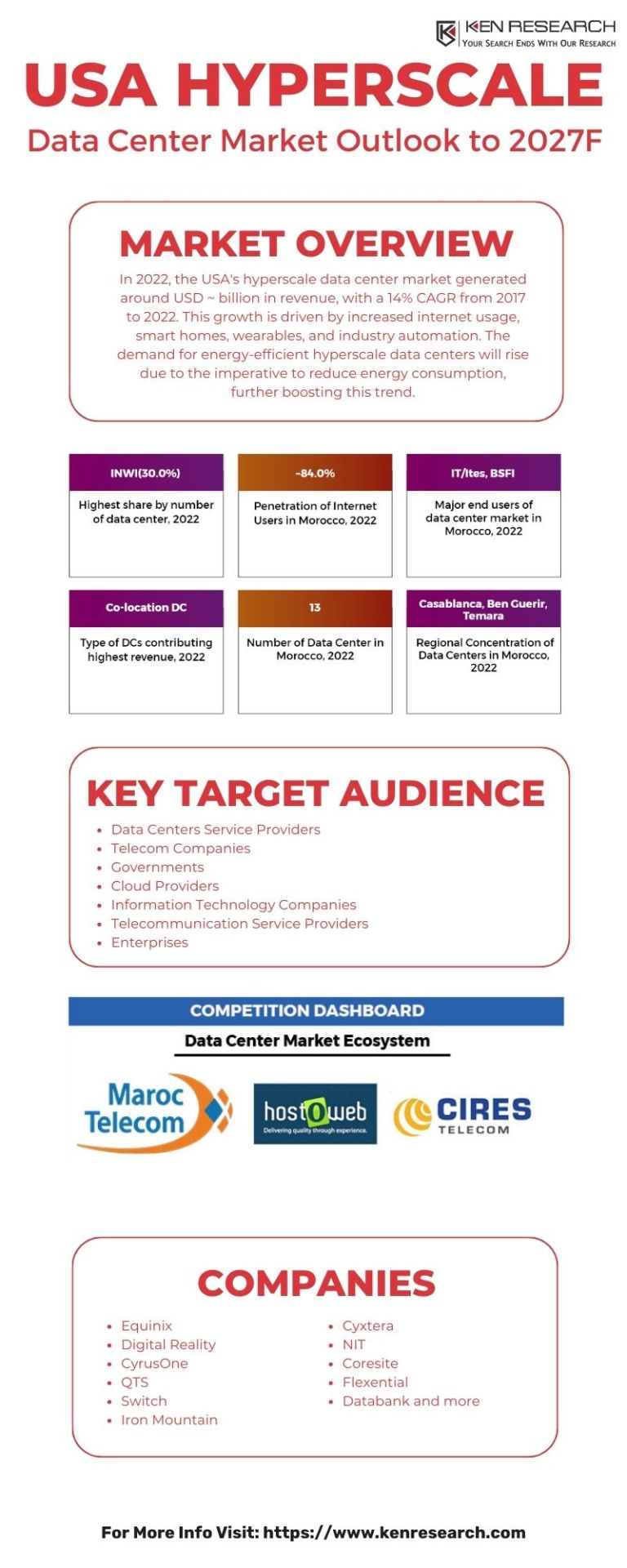
The USA Hyperscale Data Center Market is poised for significant growth, with a focus on the outlook up to 2027F. This expansion is primarily fueled by the increasing adoption of remote work and a soaring demand for cloud computing solutions.
#global data center market#Hyperscale Data Center Market#Hyper Scale Data Center Industry#Data Center Solutions#Data Center Colocation
0 notes
Text
The Hyperscale Datacenter Market is expected to reach USD 96.14 billion in 2023 and grow at a CAGR of 5.29% to reach USD 124.40 billion by 2028. Hewlett Packard Enterprise Co, Cisco Systems Inc., Huawei Technologies Co., Nvidia Corporation, Quanta Computer Inc. are the major companies.
#hyperscale data center market report#hyperscale data center industry report#hyperscale data center market#hyper scale data center market share#hyperscale data center market size#hyperscale data center industry#hyper scale data center market growth#hyperscale data center market trends#hyperscale data center market analysis
0 notes
Text
Data Center Market Size, Growth, Trends, and Future Outlook
The data center market is experiencing explosive growth, fueled by the ever-increasing demand for data storage, processing, and connectivity. These facilities, which house the computing infrastructure powering our digital world, are witnessing a surge in investment and innovation. This article explores the current state of the data center market, analyzing its size, growth trajectory, key trends, prominent players, and future outlook.
Market Size and Growth:
The data center market size was valued at $229.23 billion in 2023 and is projected to reach $640.77 billion by 2032, representing a Compound Annual Growth Rate (CAGR) of 12.10%. This rapid expansion is driven by factors such as:
The rise of cloud computing: Businesses are increasingly migrating their applications and data to the cloud, necessitating the construction of new data centers by cloud providers.
Growing internet penetration: As more users and devices connect to the internet, the demand for data storage and processing capabilities increases.
The proliferation of data-driven technologies: Artificial intelligence, big data analytics, and the Internet of Things (IoT) are creating an exponential growth in data generation, requiring robust data center infrastructure.
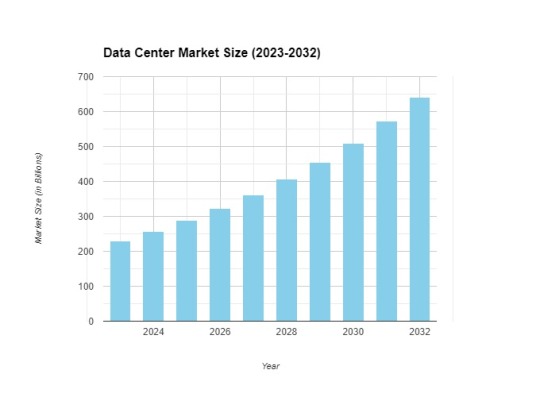
Market Trends:
Several key trends are shaping the data center market landscape:
Shift towards hyperscale data centers: Large, centralized data centers built by major cloud providers like Amazon Web Services (AWS), Microsoft Azure, and Google Cloud Platform are becoming increasingly dominant.
Emergence of edge computing: Data processing is migrating closer to the source, with smaller edge data centers being deployed closer to users and devices to reduce latency and improve responsiveness.
Focus on sustainability: As environmental concerns mount, data center operators are adopting energy-efficient technologies and renewable energy sources to minimize their carbon footprint.
Growing demand for colocation: Businesses are opting for colocation services, where they rent space and resources in a data center owned by another company, to avoid the upfront costs and operational complexities of building and managing their own data centers.
Data Center Companies:
The competitive landscape of the data center industry is marked by the presence of key players, each contributing to the market's growth and innovation. Amazon Web Services (AWS), Microsoft Corporation, and Google Cloud are among the major players dominating the cloud services segment, offering scalable and reliable infrastructure to businesses globally.
In addition to cloud providers, there are prominent data center infrastructure players like Dell Technologies, Hewlett Packard Enterprise (HPE), and Cisco Systems. These companies provide a range of hardware solutions, including servers, storage, and networking equipment, essential for building and maintaining data center facilities.
Moreover, colocation service providers like Equinix, Digital Realty, and CyrusOne offer facilities where multiple customers can house their servers and networking equipment. Colocation services are gaining popularity due to their cost-effectiveness and the ability to provide businesses with flexible and scalable infrastructure.
Data Center Market Research Reports:
To gain comprehensive insights into the data center market, businesses and industry stakeholders turn to data center market research reports. These reports provide valuable data, market trends, and forecasts, aiding decision-makers in making informed choices.
According to recent research, the Asia-Pacific region is anticipated to witness the highest growth in the data center market, driven by the rapid digitization of economies, increased internet penetration, and the surge in mobile device usage. Additionally, reports highlight the rising significance of modular and containerized data centers as a cost-effective and scalable solution for businesses with varying infrastructure needs.
Market Outlook:
The data center market is expected to continue its strong growth trajectory in the coming years, driven by the factors discussed above. The increasing adoption of cloud computing, big data, and AI, coupled with the growing need for secure and reliable data storage, will further fuel market expansion. Additionally, the rise of emerging economies, particularly in Asia Pacific, will present significant growth opportunities for data center operators.
#market data center#global data center#data center market#data center companies#hyperscale data center#cloud data center#datacenter or data center#data center growth projections#data center industry report#data center growth forecast#global data center market#global data center market size#data center growth#data center market growth#data center market report#data center industry#data center report#data center research#data center size#data center industry growth#data center#market research#business#ken research#market analysis#market report#market research report
1 note
·
View note
Text
Remember a couple years ago when everyone was talking about how Bitcoin alone was using as much energy as a medium-sized country to enable rampant speculation and financial scams? The demand was so high in some jurisdictions that it was keeping fossil-fuel power plants from being taken offline, and even reactivating some defunct polluting generation infrastructure. Crypto’s environment toll was rightfully seen as unconscionable to many people following the industry. But the generative AI boom is taking it to a whole new level.
Since the launch of ChatGPT in December 2022, the entire tech industry has reoriented itself to try to get a boost from the interest in generative AI and many sectors beyond have pretended they’re doing something with artificial intelligence (AI) too in the hopes of increasing their share price. But if there are any winners from the AI hype, it’s the companies running the data centers — especially Microsoft, Google, and Amazon — and those making the chips that power it all. Nvidia is the standout example in that category, given its ascent to become one of the most valuable publicly traded companies in the world and the questions that’s prompted about the AI bubble.
All those generative AI tools are incredibly computationally intensive, which means they require a lot of dedicated hardware within massive hyperscale data centers owned by the cloud oligopoly, and all that computing power requires a immense amount of water and electricity to keep it running. If you’ve followed tech investment news over the past year, you’ve been seeing the effect of that as Microsoft, Google, and Amazon have dropped billions of dollars every few weeks on new communities around the world for new data center projects.
24 notes
·
View notes
Quote
In the first half of 2023, North America set a record for data-center construction, up 25% in the top eight markets. And that's just for data centers that lease out server space to other businesses. Tech giants such as Google, Microsoft, Amazon, and Meta — so-called hyperscalers — are spending billions of dollars more to build out their own data centers.
The Coming Tsunami of AI Data Centers
2 notes
·
View notes
Text
MTP/MPO Fiber Optic Cable: Types and Their Applications
With ever-greater bandwidths and network connections to deal with in data centers, traditional duplex fiber patch cords like LC fiber patch cords no longer meet the demands. To solve this issue, MTP/MPO fiber optic cable that houses more fibers in a multi-fiber MTP/MPO connector was introduced in the market as a practical solution for 40G/100G/400G high-density cabling in data centers. This article will introduce different MTP/MPO cable types and their applications.
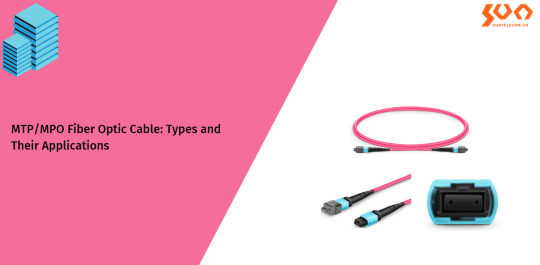
What is MTP/MPO Cable?
MPO (multi-fiber push-on) is the first generation of clip-clamping multi-core fiber optic connectors. MTP is an advanced version of MPO with the better mechanical and optical performance. They look similar and are fully compatible and interchangeable.

MTP/MPO cable consists of MTP/MPO connector and optical fiber. MTP/MPO connector has a female type (without pins) or a male type (with pins). MTP/MPO connector increases the fiber optic cable density and saves circuit card and rack space, which is well suited for current data center cabling and future network speed upgrades.
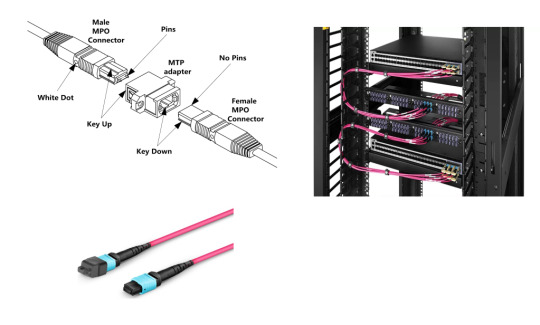
MTP/MPO Cable Types
MTP/MPO cable types are classified based on function, polarity, fiber count, fiber mode, and jacket rating.
By Function
Based on function, MPO/MTP cable type is divided into MTP/MPO trunk cable, MTP/MPO breakout cable, and MTP/MPO conversion cable.
MTP/MPO Trunk Cable
MTP/MPO trunk cable is terminated with an MTP/MPO connector (female/male) on both ends, which is available in 8-144 fiber counts for users’ choices. Typically, MTP/MPO trunk cable is ideal for creating a structured cabling system, including backbone and horizontal interconnections such as 40G-40G and 100G-100G direct connections.

2.MTP/MPO Breakout Cable
MTP/MPO breakout cable (aka. harness cable or fanout cable) is terminated with a female/male MTP/MPO connector on one end and 4/6/8/12 duplex LC/FC/SC/ST connectors on the other end, such as 8-fiber MTP/MPO to 4 LC harness cables and 12-fiber MTP/MPO to 6 LC harness cables. Typically, MTP/MPO breakout cable is ideal for short-range 10G-40G and 25G-100G direct connections or for connecting backbone assemblies to a rack system in the high-density backbone cabling.

3.MTP/MPO Conversion Cable
MTP/MPO conversion cable has the same fanout design as MTP/MPO breakout cable but is different in fiber counts and types. MTP/MPO conversion cable is terminated with MTP/MPO connectors on both ends. MTP/MPO conversion cable is available in 24-fiber to 2×12-fiber, 24-fiber to 3×8-fiber, and 2×12-fiber to 3×8-fiber types, and is ideal for 10G-40G, 40G-40G, 40G-100G, and 40G-120G connections, which eliminate fiber wasting and largely increase the flexibility of the MTP/MPO cabling system.
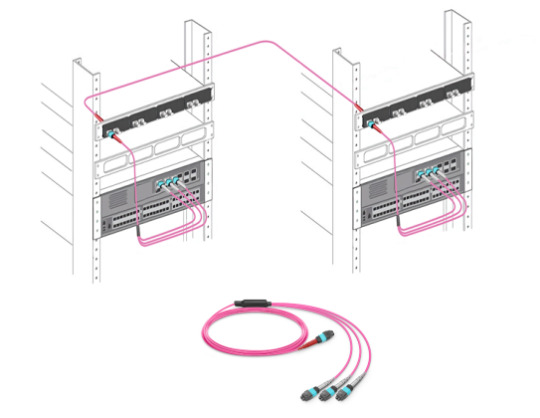
By Polarity
Polarity refers to the difference between the optical transmitters and receivers at both ends of the fiber link. Due to the special design of MTP/MPO connectors, polarity issues must be addressed in high-density MTP/MPO cabling systems. To guarantee the correct polarity of the optical path, the TIA 568 standard defines three connection methods, called Type A, Type B, and Type C. The cables of the three MTP/MPO connector types have different structures.
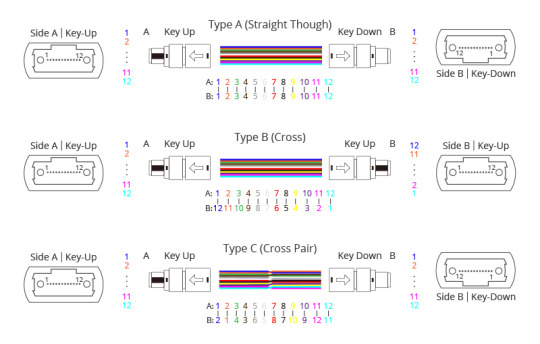
By Fiber Count
Based on fiber count, MTP/MPO cable type is divided into 8/12/16/24 fiber. The 8-fiber MTP/MPO cable can transmit the same data rate as 12-fiber, but with lower cost and insertion loss, making it a more cost-effective solution. 12-fiber MTP/MPO cable is the earliest developed and most commonly used solution in 10G-40G and 40G-100G connections. If it is used in 40G QSFP+ or 100G QSFP28 transceivers, 4 fibers will be idle, resulting in low fiber utilization.16-fiber MTP/MPO is designed for 800G QSFP-DD/OSFP DR8 and 800G OSFP XDR8 optics direct connection and supporting 800G transmission for hyperscale data center. 24-fiber fiber MTP/MPO cable is used to establish a 100GBASE-SR10 connection or 400G connection between CFP and CFP transceivers.

By Fiber Mode
Based on fiber mode, MTP/MPO cable includes single-mode (SM) and multi-mode (MM). SM MTP/MPO cable is suitable for long-distance transmissions, such as in metropolitan area networks (MANs) and passive optical networks PONs (PONs), with less modal dispersion, and it is available in OS2 type. While MM MTP/MPO cable is suitable for short-distance transmission, allowing 40 Git/s maximum transmission distance of 100m or 150m, and it is available in OM3/OM4 types.

By Jacket Rating
According to different fire rating requirements, the jackets of MTP/MPO cable types are divided into low smoke zero halogen (LSZH), optical fiber non-conductive plenum (OFNP), communications multipurpose cable plenum (CMP), etc. LSZH MTP/MPO cable is free of halogenated materials (toxic and corrosive during combustion), provides better protection for personnel and equipment in a fire, and is suitable for closed places. OFNP MTP/MPO cable contains no electrically conductive elements and is designed with the highest fire rating, which can be installed in ducts, plenums, and other spaces for building airflow. CMP MTP/MPO cable can restrict flame propagation and smoke exhaust rate during a fire, which is suitable for plenum spaces, where air circulation for heating and air conditioning systems are facilitated.
Conclusion
MTP/MPO cables provide stable transmission, high performance, high-density cabling for various environments, and prevent network bottlenecks, reduce network latency, and expand bandwidth and scalability for future network expansion. Sun Telecom provides total and customized solutions of fiber optic products to the global market. Contact us if you have any needs.
2 notes
·
View notes
Text
Pure Storage to Re-Invent Hyperscale Data Centre Storage Together with Kioxia

Pure Storage and Kioxia Corporation have entered into a partnership to offer advanced storage solutions for hyperscale data centers, which involves scalability, energy efficiency, and high-performance capabilities.
This collaboration merges Pure Storage's industry-leading data systems with Kioxia's state-of-the-art QLC flash memory, aiming at solving the unique challenges that come with modern data centres. Together, they are creating a solution tailored to the needs of hyperscale environments, with a perfect balance of speed, efficiency, and sustainability.
Overcoming the Limitations of Traditional Storage
As data volumes go through the roof, hyperscale data centres are in dire need of ever-more sophisticated storage solutions. Traditional HDDs are struggling to keep up with the demand, lacking in speed, scalability, and energy efficiency. These limitations often manifest themselves in higher latency, bandwidth constraints, and a surging consumption of power, all of which ultimately hold growth and operational effectiveness at bay.
According to Bill Cerreta, the GM of Hyperscale at Pure Storage, this collaboration will indeed enable the company to extend the advantages of all-flash storage to hyperscale environments. "Our collaboration with Kioxia leverages over a decade of experience in delivering high-performance flash storage, now tailored to the needs of hyperscalers," he said. "Together, we are developing a solution that will help organizations seamlessly manage vast amounts of data with speed and efficiency."
It will be a new, modern platform, untethered from the traditional HDD-based systems, and highly relevant to hyperscale operators interested in finding more sustainable and scalable solutions.
Bringing Innovation in Performance, Cost, and Sustainability
This partnership offers the hyperscale data centre the following important benefits:
Unrivaled Performance: The new form factor allows for ultra-high speed, low-latency functionality when it comes to moving/processing vast volumes of information. Seamlessly scale Organizations to meet the growing needs with confidence and reliability.
Cost-Effective Scalability: Because the solution reduces the requirement for extensive physical infrastructure, it lowers the total cost of ownership while still offering exceptional performance and scalability to provide a powerful, cost-effective solution for hyperscale operators.
Sustainability Focus: Compared to traditional HDD-based storage, the all-flash system cuts energy consumption drastically, hence reducing operational costs and waste from hardware. Its compact physical size also contributes to the move toward greener, more sustainable data centre operations.
Kioxia's Chief Marketing Officer, Caesar Ichimura, said, "Innovation is key to solving the increasing demands on hyperscale environments. This collaboration with Pure Storage marks an important milestone in the evolution of hyperscale storage. As data volumes rise, we are committed to delivering a solution that offers high performance at lower operational costs. All-flash technology represents the future of storage, and this partnership is key to addressing the complexities of modern data centres."
Read More: https://www.frameoutlook.com//tech-news/pure-storage-to-reinvent-hyperscale-data-centre-storage-together-with-kioxia--nid-710.html
#InventHyperscaleData#FrameOutlookMagazine#MagazineofInnovativeLeaders#InnovativeBusinessLeaders#BusinessDecisionMaking
0 notes
Text
The US data center market is rapidly expanding, due to the hyperscale facilities promoting the demand for cloud and AI services. For instance, the United States leads the hyperscale data center market, accounting for approximately 51% of the global total. This is further driving the market demand for data centers. In addition, the leading tech organizations are significantly investing in these facilities to address the demand for massive and cost-efficient facilities, boosting the market growth. Moreover, hyperscale facilities are required for substantive traffic consumption, such as video streaming services, video games, and real-time data analysis services, which is impelling the market growth. Furthermore, these services are important in the development of the processing power, storage, and connection that is needed to underpin the digital-first world across industries, thereby contributing to the market expansion.
#United States Data Center Market Size#Share#Trends and Forecast by Component#Type#Enterprise Size#End User#and Region#2025-2033
0 notes
Text
Industry trend|Rapid Growth in the Data Center Market Gives Rise to Management Challenges, This Taiwanese Company Launches RFID Solution to Solve
With the rapid development of information technologies such as cloud computing, big data, the Internet of Things and artificial intelligence, the scale of the global data center market continues to expand. In 2022, the scale of the global data center market has expanded to US$74.65 billion, a year-on-year growth rate of 9.9%, and the growth rate has remained at a good level of about 10% in the past five years. In 2023, the scale of the global data center market is about US$82.2 billion, a year-on-year increase of 10.04%. It is also predicted that the scale of the global data center market will reach US$90.4 billion in 2024. The hyperscale data center market is also growing, with a market size of US$80.2 billion in 2024 and is expected to increase to US$935 billion by 2032.
Promoted by national policies such as new infrastructure, digital transformation and the vision and goals of Digital China, the scale of my country's data center market continues to grow at a high speed. In 2022, the scale of my country's data center market has grown to 190.07 billion yuan, with a five-year compound growth rate of nearly 30%. In 2023, the scale of China's data center market is about 240.7 billion yuan, a year-on-year increase of 26.68%, and it is predicted that it will reach 304.8 billion yuan in 2024. In addition, the scale of data center racks in use is also growing steadily. As of August 2023, the total scale of data center racks in use in my country exceeds 7.6 million standard racks, and the total computing power reaches 1.97 trillion floating-point operations per second, ranking second in the world.
The rapid growth of the data center market has given rise to management challenges
At the same time, data center asset management faces many challenges, mainly including the following aspects:
Asset protection and security issues: Data centers are full of server racks, routers, modems, and servers, which are all high-value and need to be protected from theft or damage, which is usually managed through technology-based or manual security measures, but these measures can be costly and have limited effectiveness.
Inventory management complexity: There are many devices in the data center, and tracking inventory and its status (such as location, maintenance records, etc.) is a tedious and time-consuming task that requires a lot of manpower and material resources.
Environmental monitoring challenges: Data centers are often located in specific locations within a large area, and it is challenging to identify high-temperature locations, and temperature can have a significant impact on equipment health.
Lack of real-time performance: Traditional asset management methods often lack real-time performance and cannot reflect the status and location changes of assets in a timely manner, which may lead to delayed management decisions.
In addition, data centers may deploy multiple technologies and systems. It is a complicated process to integrate these technologies into a unified platform for management. Whether it is hiring workers to track or purchasing expensive data center infrastructure management (DCIM) software, it increases the operating costs of data centers.
RFID solutions reshape data center asset management
Recently, EPC Solutions Taiwan launched a new DCIM system, which has brought revolutionary changes to data center management with its innovative RFID technology and powerful functions. The DCIM solution includes internal software, as well as two boxes of hardware for each IT asset rack. One box contains the reader, and the other includes cable antennas, adapters, and metal tags. Users can order any number of readers, antennas, and tags. Effectively solve the challenges faced by data center asset management, as follows:
Anti-theft and asset tracking: The system uses UHF RFID technology to track the status of IT assets in the data center and digitally record the movement and maintenance of assets such as servers and routers. The exit portal uses fixed readers and antennas to detect tagged items. If someone attempts to remove an asset, a fixed reader antenna at the exit reads the tag, triggers the alarm system, and creates a record and time stamp of the item’s removal, effectively preventing theft and tracking assets.

Low-cost and easy-to-manage solution: EPC Solutions' DCIM solution is designed to be low-cost and easy to manage. Data center personnel can install the system in a short time, including UHF RFID readers, cable antennas, tags, etc.
Environmental monitoring and health management: The system includes environmental factor monitoring, using temperature and humidity RFID tags to capture sensor data and transmit this information when interrogated by the reader. This helps data center managers obtain real-time data about temperature or humidity to prevent equipment failure or damage.
Improve employee productivity and save costs: The advantages of the system are time saving, employee productivity and cost savings. Employees no longer need to be on-site to determine what assets are in the data center and what spaces and environments are available.
Management reports and trend analysis: The system can create management reports to analyze overall trends, racks and even specific ports, helping data center managers better understand asset conditions and operations.
Through these methods, EPC Solutions Taiwan's DCIM system provides a comprehensive and efficient solution for data center asset management, effectively addressing the many challenges faced by data center asset management. It is worth mentioning that EPC Solutions is developing a cloud version of the system to provide users with more convenient and flexible services. The technology has been tested and funded by Small Business Innovation Research (SBIR) and is expected to be officially released for commercial use in July 2025.
The DCIM system launched by EPC Solutions Taiwan brings a new solution to data center management. It uses RFID technology to achieve real-time tracking and environmental monitoring of assets, improves the accuracy and efficiency of asset management, and reduces management costs. With the commercial release of the system, it is expected to bring a more intelligent and efficient future to data center management.
This paper is from Ulink Media, Shenzhen, China, the organizer of IOTE EXPO (IoT Expo in China)

0 notes
Text
Data Center Market: Size, Growth, Trends, and Outlook
Introduction
The Global Data Center Market has witnessed unprecedented growth in recent years, fueled by the exponential increase in digital data, cloud computing adoption, and the rise of edge computing. As businesses continue to embrace digital transformation, the demand for robust data center infrastructure becomes paramount. In this article, we explore the current state of the Data Center Market, examining their market size, market trends, future outlook, key players, growth rate, opportunities and challenges they face.
Data Center Market Size and Growth
The Data Center Market has seen remarkable expansion, with its size reaching a staggering $170.21 billion in 2022 and is projected to grow at a CAGR of 12.4% from 2022 to 2027. This growth is fueled by the increasing reliance on data-intensive applications, the proliferation of IoT devices, and the surge in remote working arrangements.

Data Center Market Trends
Edge Computing Adoption:
The rise of edge computing, driven by the need for real-time data processing, is a key trend. Players are investing in edge data centers to reduce latency and enhance user experience.
Hybrid and Multi-Cloud Strategies:
Organizations are adopting hybrid and multi-cloud strategies to leverage the strengths of different cloud providers, optimizing performance and flexibility.
AI and Machine Learning Integration:
Data center operators are increasingly incorporating AI and machine learning to optimize resource utilization, enhance predictive maintenance, and automate various operational tasks.
Containerization and Microservices:
The adoption of containerization and microservices architecture is growing, enabling better scalability, flexibility, and efficiency in managing applications within data centers.
5G Infrastructure Development:
The rollout of 5G networks is driving the need for data centers with low latency and high bandwidth capabilities. Data center market players are investing in 5G-ready infrastructure to support the evolving needs of telecommunications networks.
Data Center Market Key Players
Amazon Web Services (AWS):
Market Size and Share: AWS, a subsidiary of Amazon.com, dominates the cloud services market with a 32% global market share.
Services: AWS offers a comprehensive suite of cloud computing services, including compute power, storage, databases, machine learning, and analytics.
Microsoft Corporation:
Market Size and Share: Microsoft Azure holds a 20% share of the global cloud services market.
Services: Microsoft Azure provides a wide range of services, from virtual computing to analytics, artificial intelligence, and IoT solutions.
Google Cloud Platform (GCP):
Market Size and Share: GCP commands a 9% share of the global cloud market.
Services: GCP offers cloud computing, storage, machine learning, and data analytics services, catering to a diverse range of businesses.
IBM Corporation:
Market Size and Share: IBM's market share in the cloud services sector stands at 5%.
Services: IBM Cloud provides a hybrid cloud platform, AI-powered solutions, and blockchain services to enterprises.
Challenges Faced by Players
Despite the immense growth opportunities, the Data Center Industry faces several challenges. One significant challenge is the increasing cost of building and maintaining data centers, including expenses related to power consumption and cooling systems. Additionally, concerns about data security and privacy pose ongoing challenges, prompting companies to invest heavily in robust cybersecurity measures.
Data Center Market Future Outlook and Opportunities
The future outlook for the Data Center Market is promising, driven by emerging technologies like 5G, edge computing, and the increasing adoption of AI and machine learning. The growing demand for hyperscale data centers, which can accommodate vast amounts of data and computing resources, presents a significant opportunity for market players.
As the market evolves, key players are expected to focus on sustainability initiatives, incorporating energy-efficient technologies and renewable energy sources into their data center operations. This trend aligns with the global push for environmentally responsible business practices.
Conclusion
The Data Center Market is experiencing a period of dynamic growth, driven by technological advancements and the increasing digitalization of businesses. As key players continue to innovate and expand their offerings, the market's future looks promising. However, addressing challenges such as sustainability, security, and cost management will be crucial for sustained success in this rapidly evolving landscape.
#market research#business#ken research#market analysis#market report#market research report#data center#hyperscale data center#data center management
1 note
·
View note